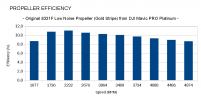
The chart shows that when the propeller reaches 4874 rpm, it has an efficiency of almost 9% (8.6% to be exact). However, as the rpm increases further, the efficiency drops further. If one propeller reaches 4874 rpm, it produces a thrust of about 185 g and four propellers produce a total thrust of 740 g. And since the weight of the drone is 734 g, at 4874 rpm it starts to climb upwards. So increasing the rpm further would not make any more sense regarding the graph.
But the propeller efficiency of 8.6% achieved is not dazzling, creating room for significant propeller innovation. Every propeller designer should be interested in achieving the highest possible efficiency in a propeller, which will allow further modifications to significantly improve other parameters (noise, thrust, acceleration or battery life).











